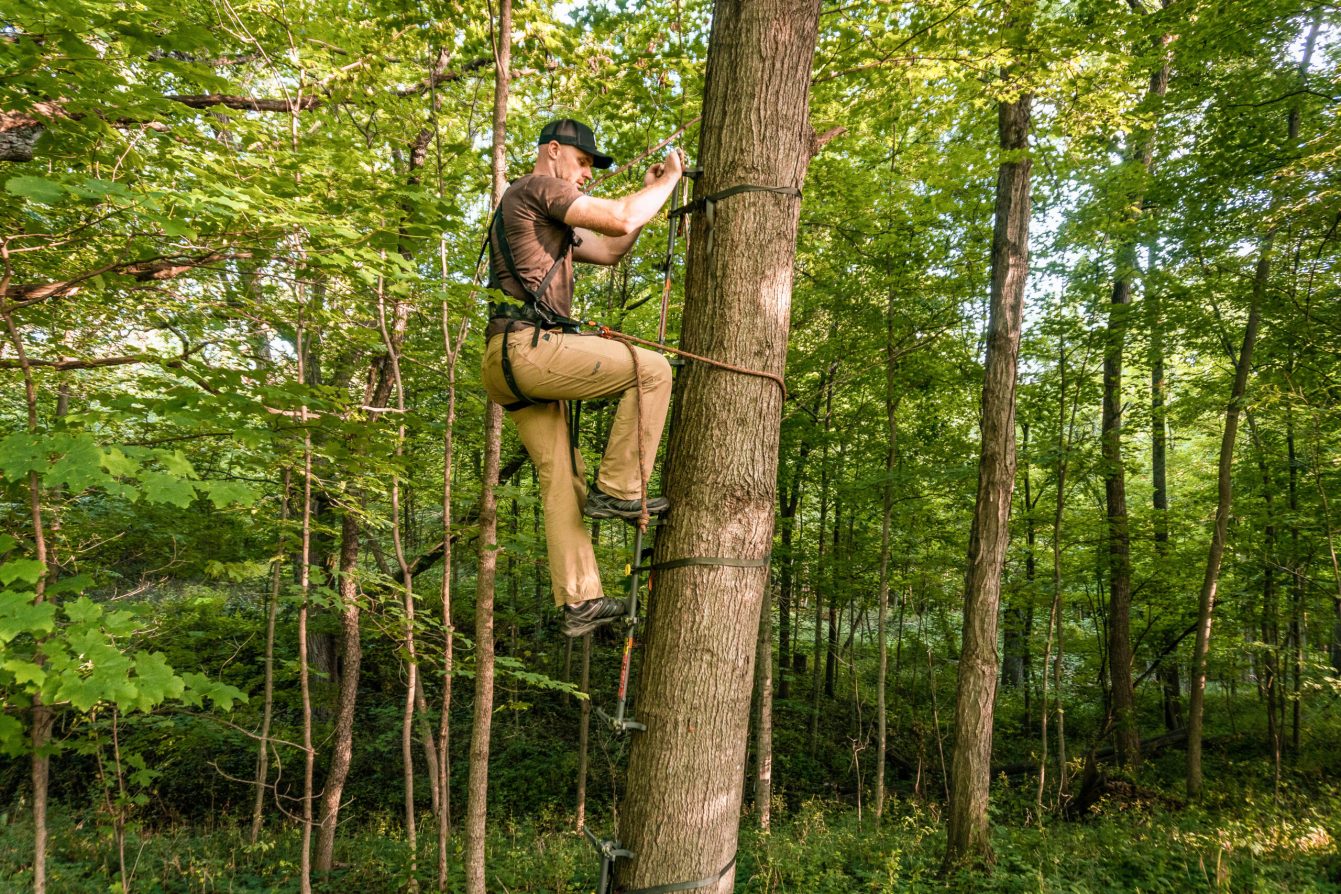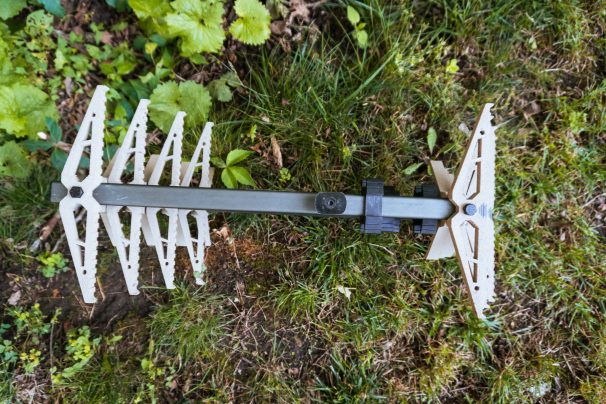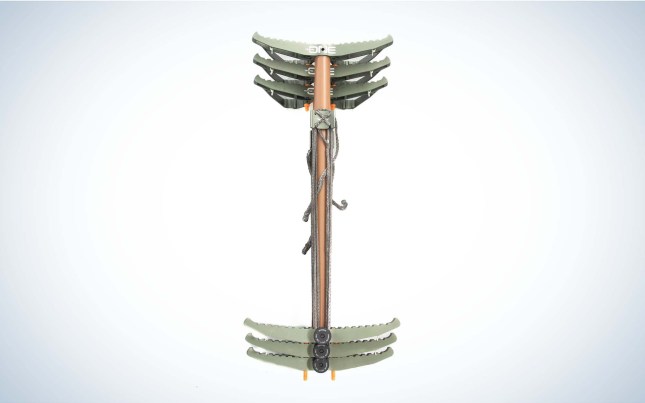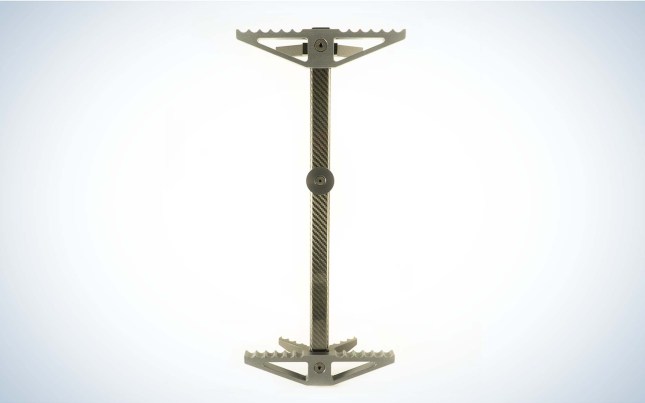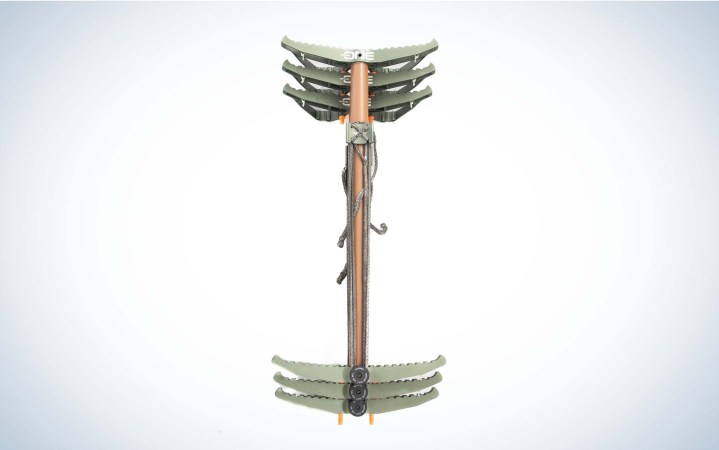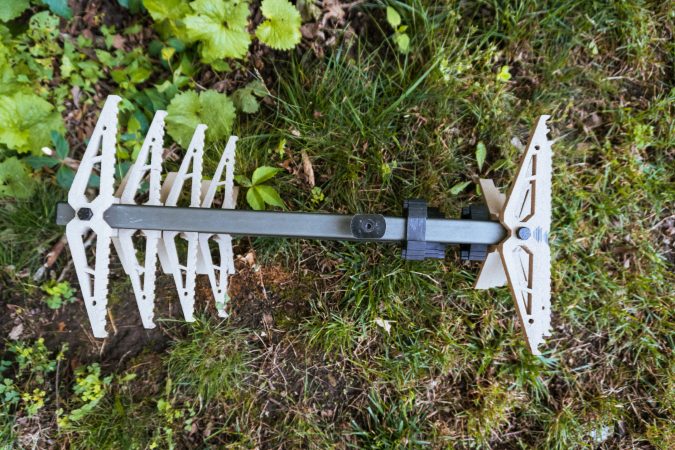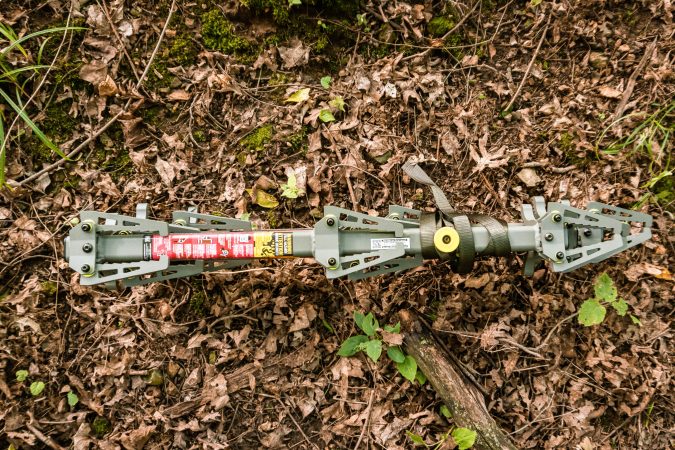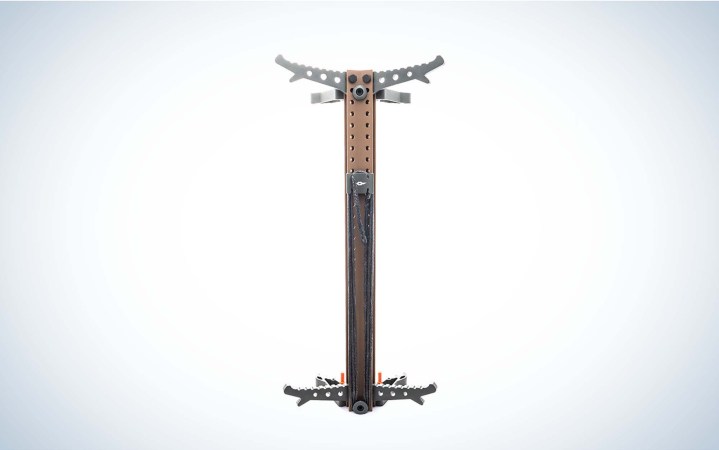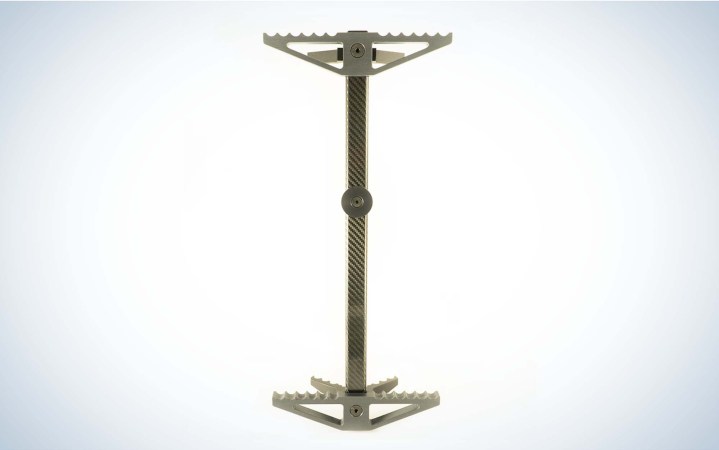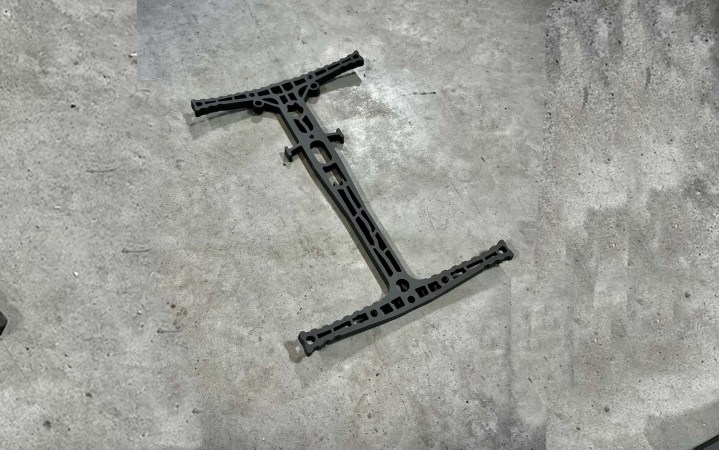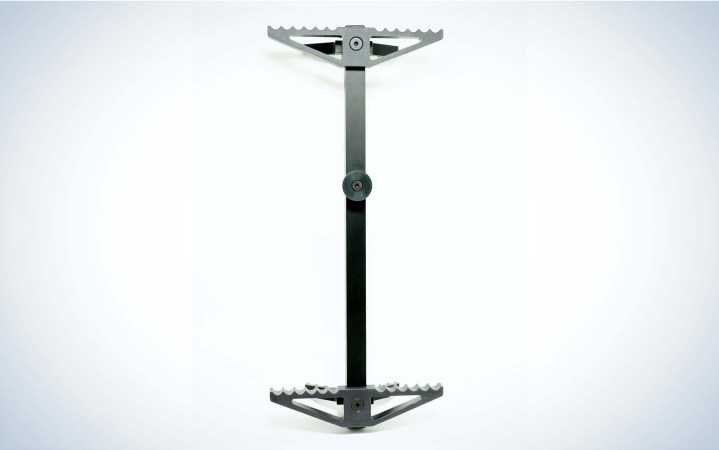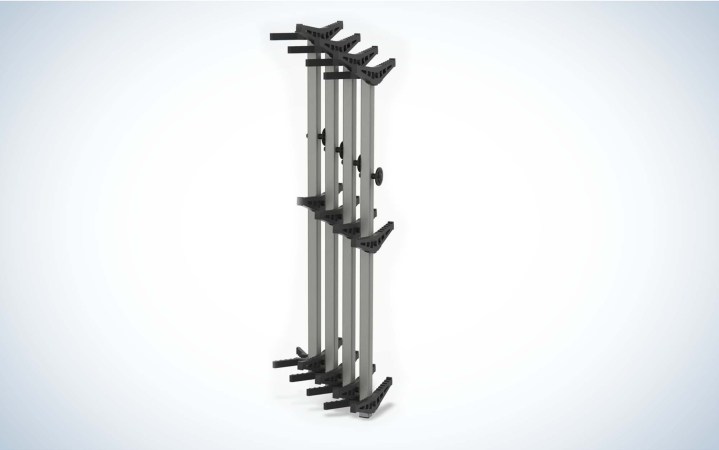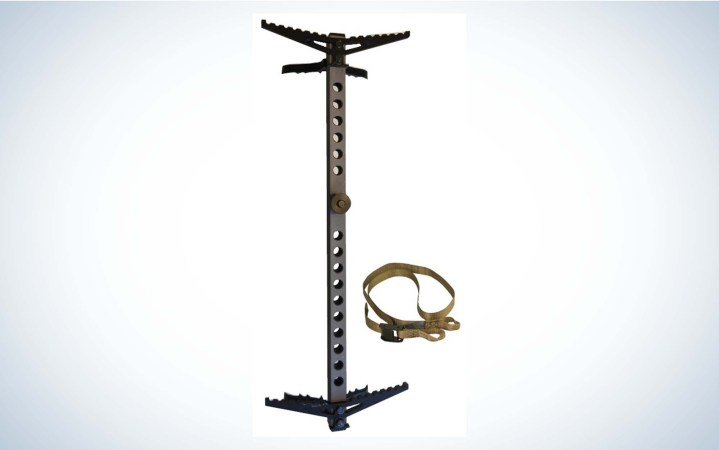We may earn revenue from the products available on this page and participate in affiliate programs. Learn More ›
The days of hauling heavy, noisy climbing sticks through the woods are behind us. Modern climbing sticks are purpose built with the mobile hunter top of mind, resulting in climbing methods that are lighter, quieter, and far more mobile than their clunky predecessors.
This means hunters you have a lot of options when it comes to shopping for your next set of climbing sticks, so I spent time comparing the best of the best to create a guide to buying the best climbing sticks for you.
- Best Overall: Tethrd One Climbing Stick
- Best Budget: XOP X2 Climbing Stick
- Best for Semi-Permanent Sets: Summit Aluminum Folding Climbing Sticks
- Tethrd Skeletors
- Quietest: Timber Ninja C1
- Most Compact: Lone Wolf Custom Gear D’Acquisto Series Double Step
- Timber Ninja A1
- Novix Double-Step Climbing Sticks
- Beast Gear Climbing Stick
How I Tested Climbing Sticks
The rolling topography and vast hardwood ridges that makeup southwest Wisconsin’s Driftless Area is one of the most prolific big buck hunting areas in the country. Laden with various species of oaks, walnut, and maple trees with interspersed cedar thickets and agricultural transitions, the region is representative of classic whitetail habitat. I conducted the test on various trees on a state-owned property that’s open to public hunting. The test focused on the key factors bowhunters consider when it comes to spending their hard-earned cash: weight and size, stackability, attachment method, material, noise, and climbing comfort.
Weight and Length
I used a kitchen scale to weigh each stick to the nearest 1/10-ounce and measured length from step-to-step.
Stackability
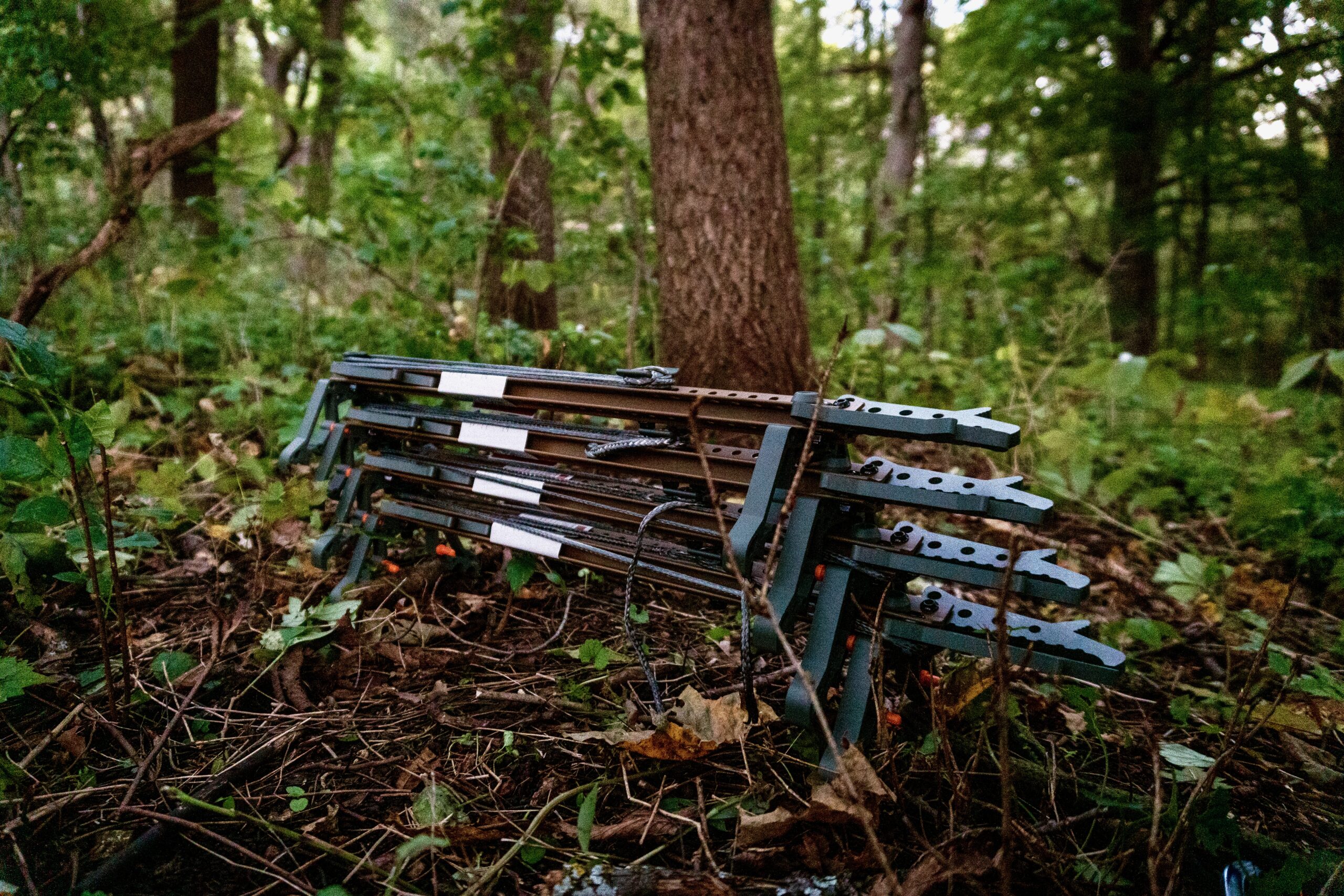
I scored each stick for their stackability from one to five, with five being the best. The score was from packed height, length, and width dimensions as well as ease of packing, how well they stay packed, and how quiet they were once stacked.
Noise
No matter how careful you are, you’re bound to make noise when setting up your sticks. Most noise is derived from the combination of the climbing stick and attachment materials. The perceived sound made while setting was given a score of one to five (five is the quietest).
Climbing Comfort
All sticks were used to climb a variety of trees throughout the test. A climbing comfort score was built on a one-to-five scale, with five being most comfortable. This was judged by seeing how well the sticks bit into the trees, noting any significant slipping or twisting experienced during the climb.
The Best Climbing Sticks: Reviews and Recommendations
Best Overall: Tethrd One Stick
Key Features
- Weight: 4 pounds 3.8 ounces (four sticks); about 1 pound 1 ounce per stick
- Length: 17 5/8 inches (step to step)
- Packed Dimensions: 22-inches long, 7 ½-inches high, and 9-inches wide
- Attachment: 103 ½ inches of Amsteel DynaLite rope
- Material: Titanium and aluminum
- Stackability Score: 4
- Noise Score: 3
- Climbing Comfort Score: 4
Pros
- Lightweight
- Plenty of amsteel rope to climb large trees
- Pack together tightly and silently
Cons
- Require aftermarket solutions to reduce noise
All the climbing sticks I tested were impressive, but the Tethrd One stick stood out as the best of the best. Weighing in at just over 4 pounds, they’re the lightest of the bunch. Tethrd prides itself on eliminating the “fiddle factor” in bowhunting, which is evident in the Amsteel DynaLite rope attachment method of their sticks. With more than 100-inches of material to grip the tree, this system makes it possible to climb trees significantly larger than what’s possible with stock offerings from other manufacturers. This method is versatile, silent, and easy to use.
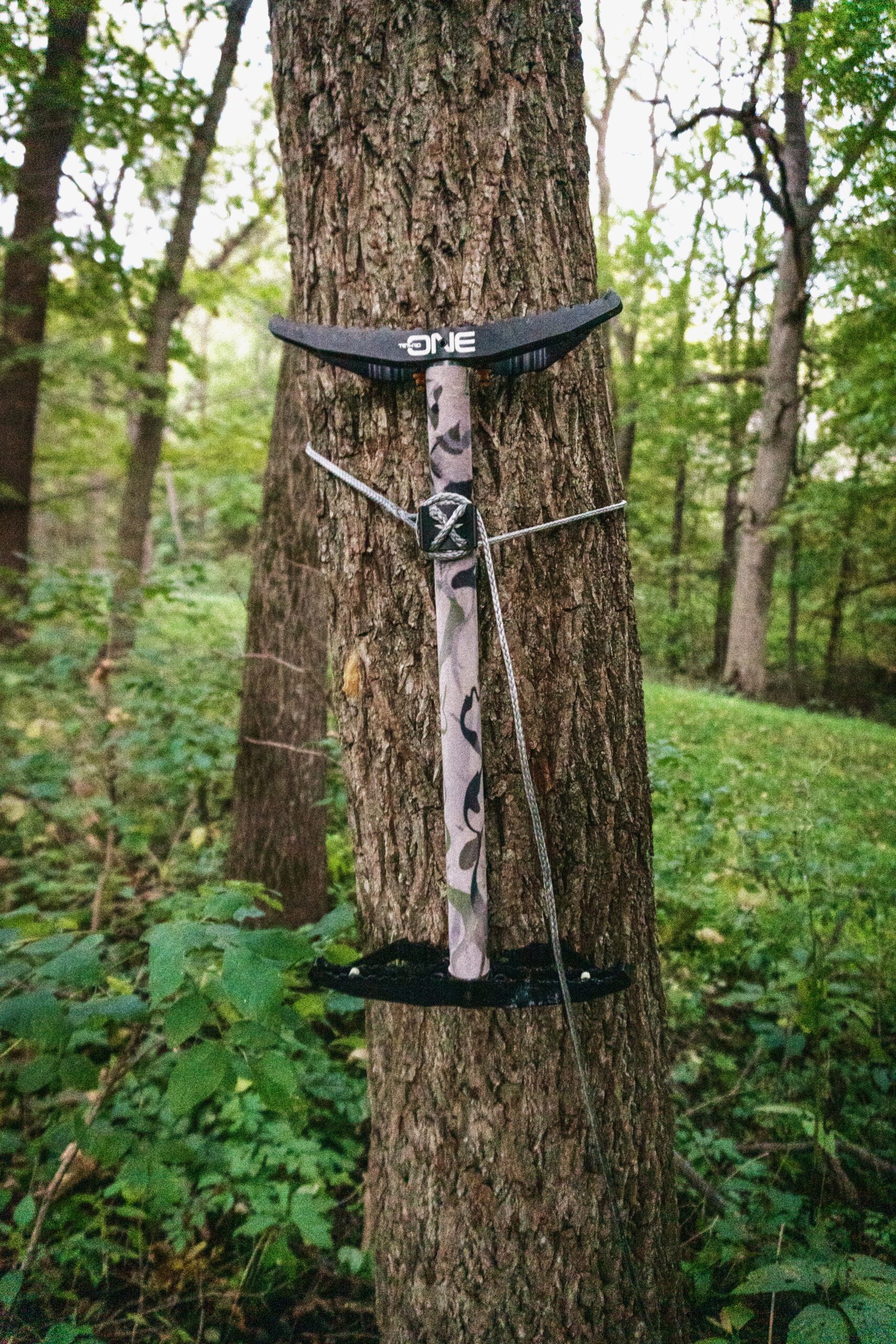
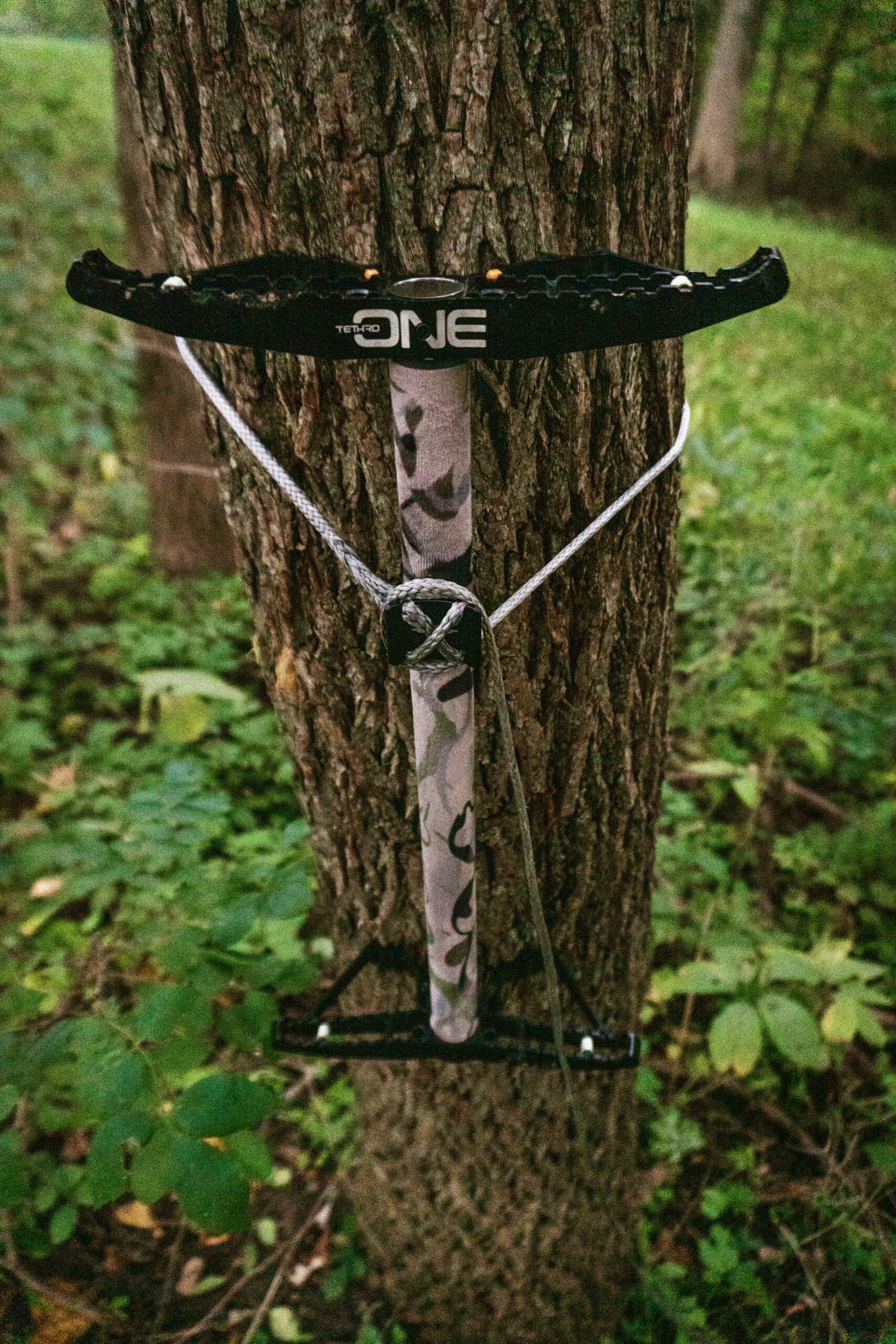
While testing stackability, I found the StickLoc pin system kept the sticks snug and silent during transport, and easy to pack. Simply align the pins into the corresponding receiver slots and snug them together and sneak out of the woods silently.
The Tethrd One sticks were a bit louder out of the box than other sticks, but that’s to be expected of a 1-pound metal climbing stick. Stealth Strips can be purchased from Tethrd directly, pre-cut to match the One stick’s design. If you want to go crazy, you can do plenty of modifications to make them even quieter.
Best Budget: XOP X2 Climbing Stick
Key Features
- Weight: 6 pounds 12 ounces (four sticks); 1 pound 11 ounces per stick
- Length: 17 inches (step to step)
- Packed Dimensions: 22-inches long, 5 5/16-inches high, 10 13/16-inches wide
- Attachment: 77 inches of cam strap buckle
- Material: 6061, 7075 aluminum
- Stackability Score: 4
- Noise Score: 4
- Climbing Comfort Score: 5
- Price: $179 (4 sticks), $132 (single stick)
Pros
- Affordable
- 5-inch standoff for easy climbing
- Side-Lock system stacks sticks side by side for silent transport
- Includes predrilled attachment points for amsteel aiders
Cons
- Included cam strap buckles are heavy (four buckles weigh 1 pound 12 ounces)
In testing, the XOP X2 Climbing Sticks hit the sweet spot of performance and affordability, which made it my pick for the best climbing stick for the money. At 6 pounces 12 ounces and $180 for a four-pack the X2 has a great price to weight ratio.
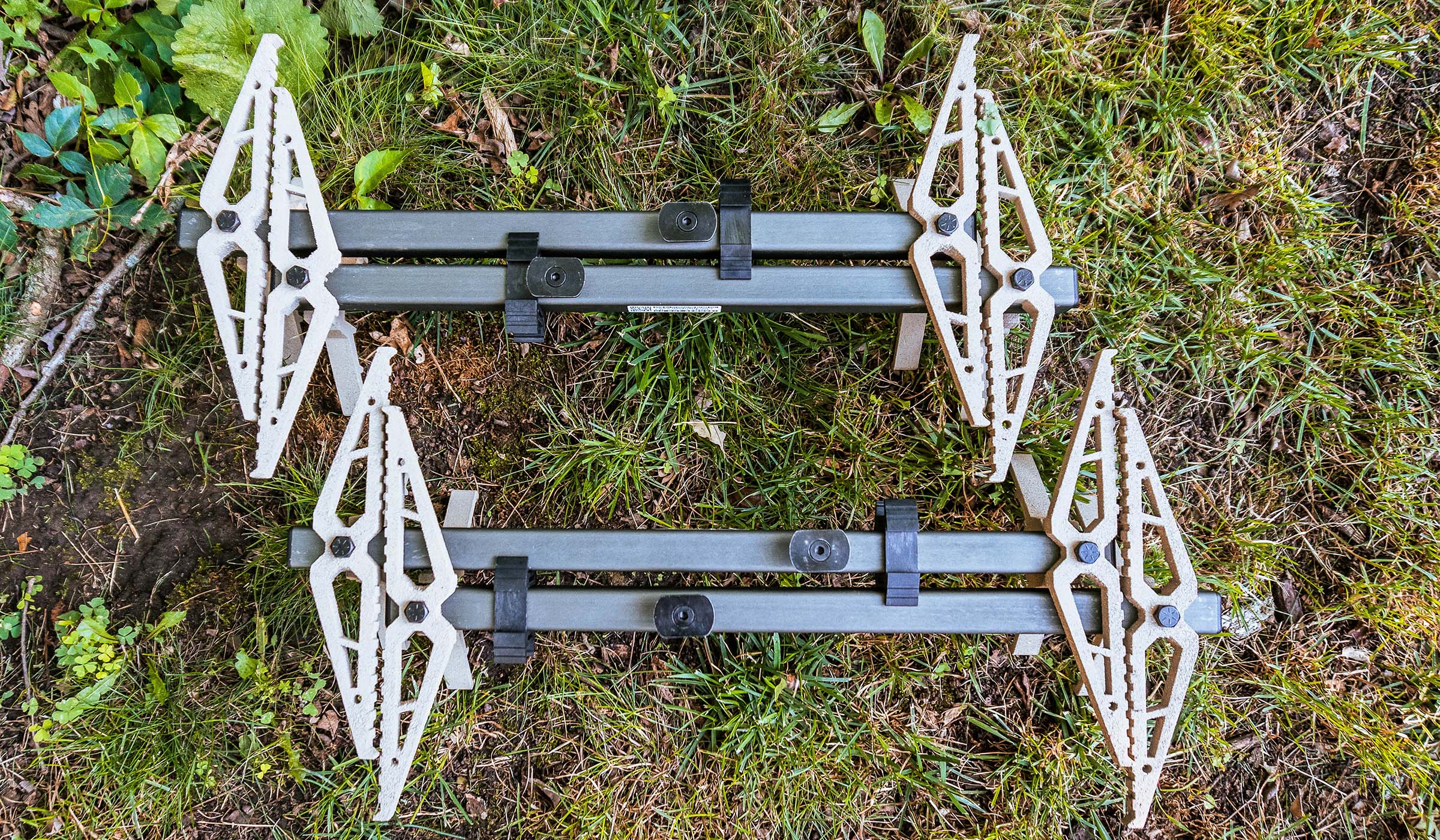
The Side-Lock attachment system is unlike other attachment method on the market, stacking the X2 sticks side-by-side for a flat, sleek profile. Just over 5-inches high when packed in the Side-Lock system, the X2 packs to a lower profile than any other stick in the test. The sticks easily slide in and out of the Side-Lock bracket, making for easy setup or takedown, especially in the dark. It’s important to note, you cannot stack a complete set of four X2 sticks side-by-side. Instead, the Side-Lock system combines two sets of pairs, which you’ll store separately (or attach to your stand, specifically made to integrate with the XOP Cold World and Retrograde treestands). The X2 sticks also stack vertically, but won’t lock in place as they would with the Side-Lock system.
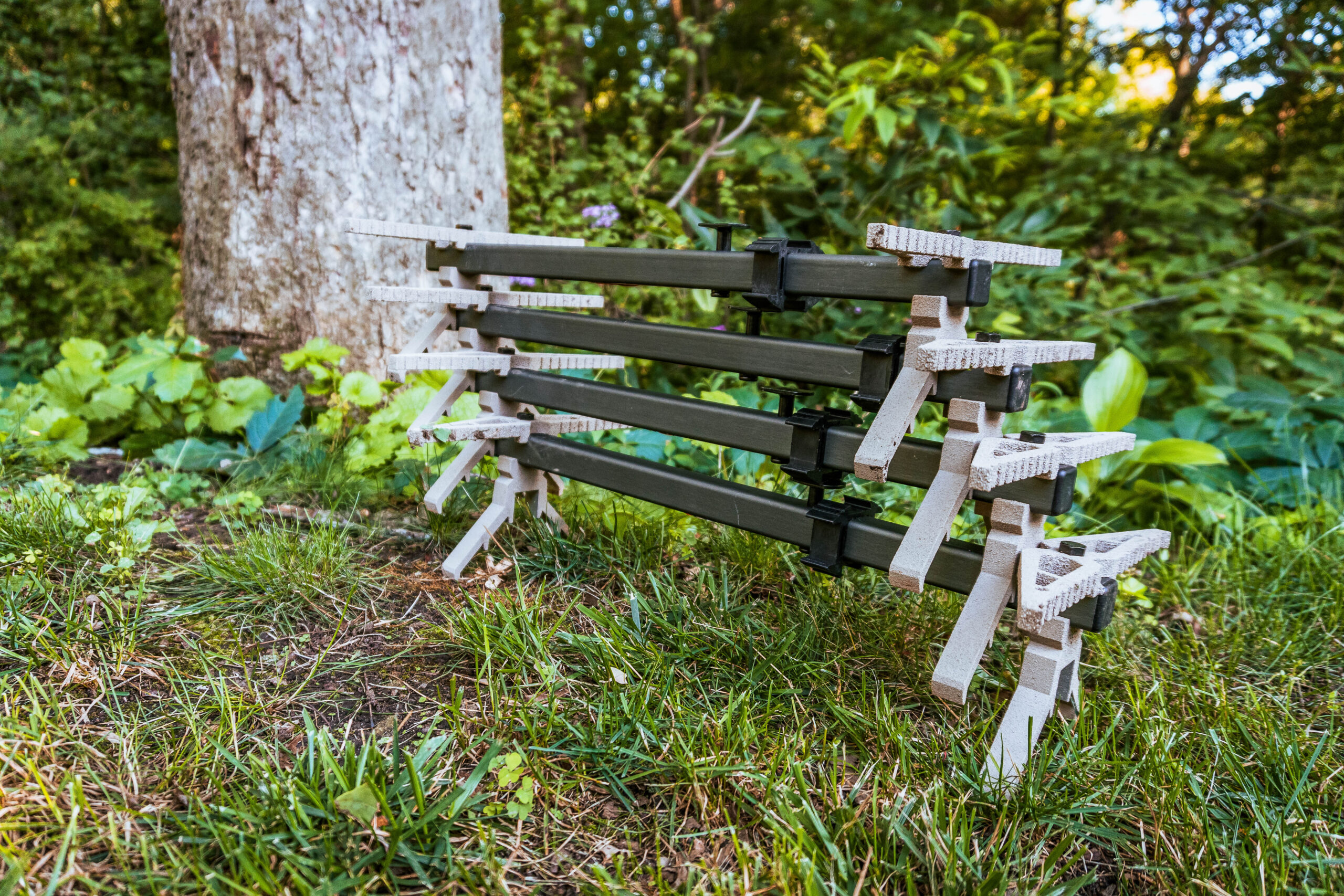
The 5-inch standoff makes the X2 comfortable and easy to climb, even with bulky insulated boots. I found the Dura-Grip Traction, a sand imbedded powder coat, to be the most abrasive and tacky exterior coating of all sticks featured in the test. The added traction allowed me to climb confidently, knowing the X2 will provide a better climbing experience than other sticks, especially if rain or snow are in the forecast.
Best for Semi-Permanent Sets: Summit Aluminum Folding Climbing Sticks
Key Features
- Weight: 10 pounds 5 ounces (three sticks); 3 pounds 7 ounces per stick
- Length: 28 inches (step to step)
- Packed Dimensions: 37-inches long, 8 1/4-inches high, 5-inches wide
- Attachment: 74 ¼ cam strap buckle
- Material: Aluminum
- Stackability Score: 1
- Noise Score: 3
- Climbing Comfort Score: 5
- Price: $169.99 (three sticks)
Pros
- Affordable
- Folding steps
Cons
- At 37-inches long when packed, they’re not ideal for mobile hunting
The Summit Aluminum Folding Climbing Sticks are quiet and easy to climb once attached to your favorite tree. If you’re looking for a run-and-gun setup, there are better alternatives to consider. However, the Summit Aluminum Folding Climbing Sticks are an excellent choice if you have several permanent stand locations and want a quiet, comfortable climbing stick.
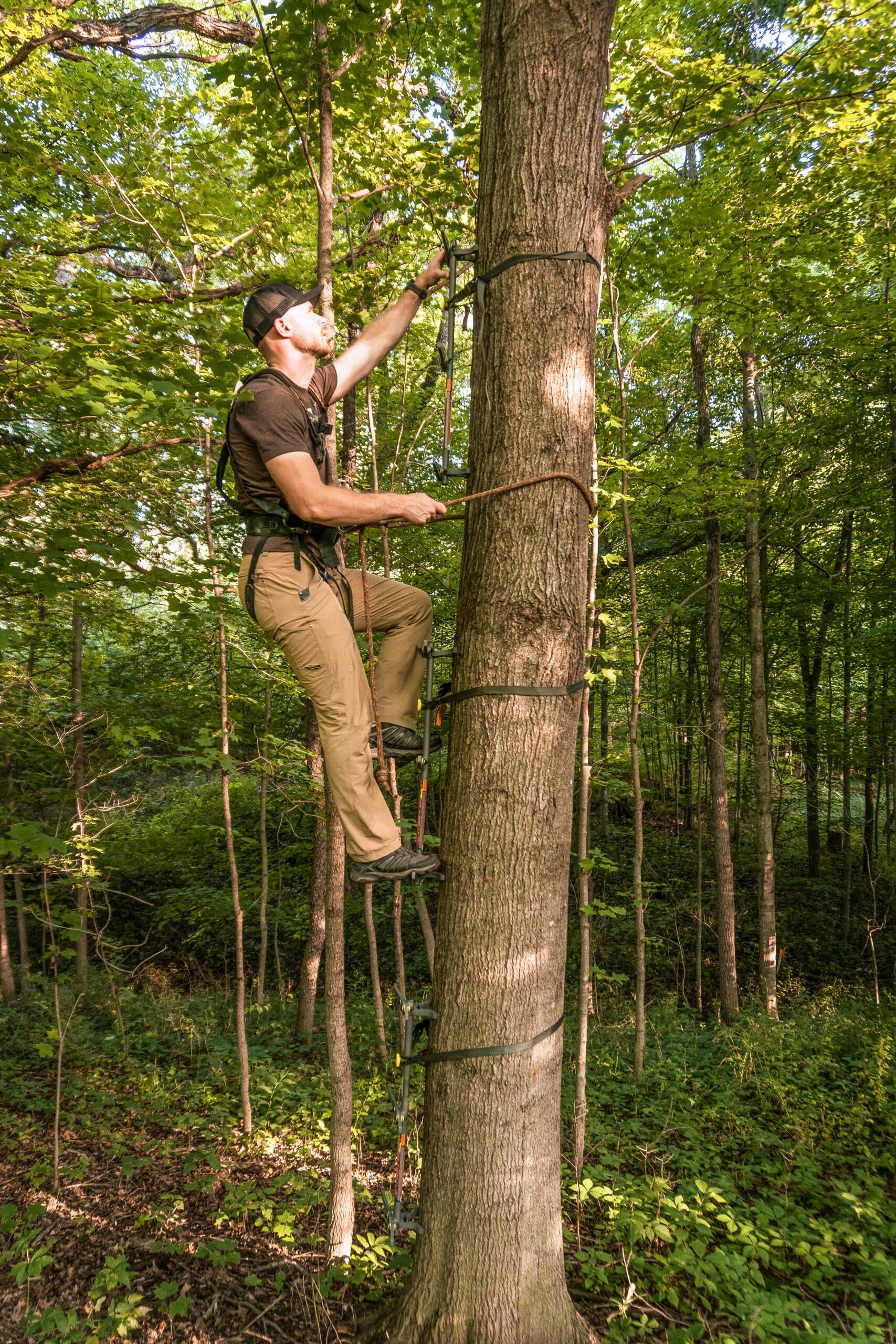
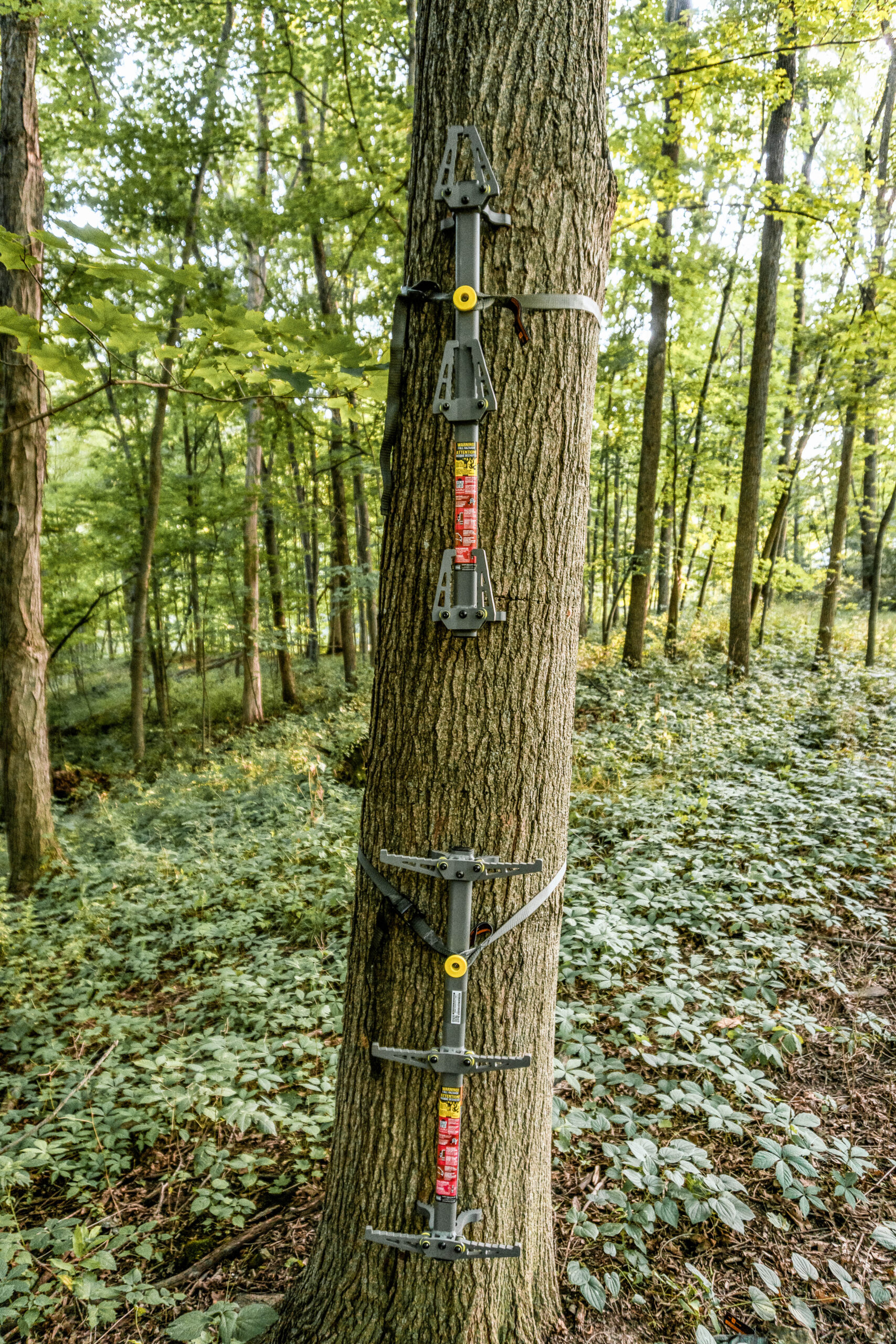
While mobile hunting seems to be the latest trend in bowhunting, many of us have our favorite spots we frequent year after year. At $170, the Summit Aluminum Folding Climbing Sticks won’t break the bank when compared to other three-step sticks featured in the test. Steps fold from 4 3/8 inches to 11 inches, which allows for plenty of room to ascend or descend with confidence, even in the dark. At 28 inches from the bottom step to top, the three-step design is plenty to reach optimal bowhunting height with just three sticks. While they can be stacked together when a minor adjustment is necessary, I wouldn’t recommend long treks or using them for frequent hang and hunts.
Tethrd Skeletor
Key Features
- Weight: 8 pounds 7 ounces ( Four sticks); about 2 pounds 2 ounces per stick
- Length: 18 ⅞ inches (step to step)
- Packed Dimensions: 26 ¼-inches long, 9-inches high, 6 ¼-inches wide
- Attachment: 98 inches of Amsteel DynaLite Rope
- Material: Aluminum
- Stackability Score: 3
- Noise Score: 3
- Climbing Comfort Score: 4
Pros
- Affordable
- Pack together tightly and silently
- Folding double-step design
Cons
- Heavier than most other sticks tested
The Tethrd Skeletors feature an Amsteel DynaLite rope attachment method, offering versatility to climb a wide range of tree diameters. A folding double-step design means the steps pivot 90 degrees for streamlined transportation. You’ll find the same proven StickLoc pin system from the One sticks, but with an added Rope Containment System to easily stow your DynaLite rope when transporting your sticks.
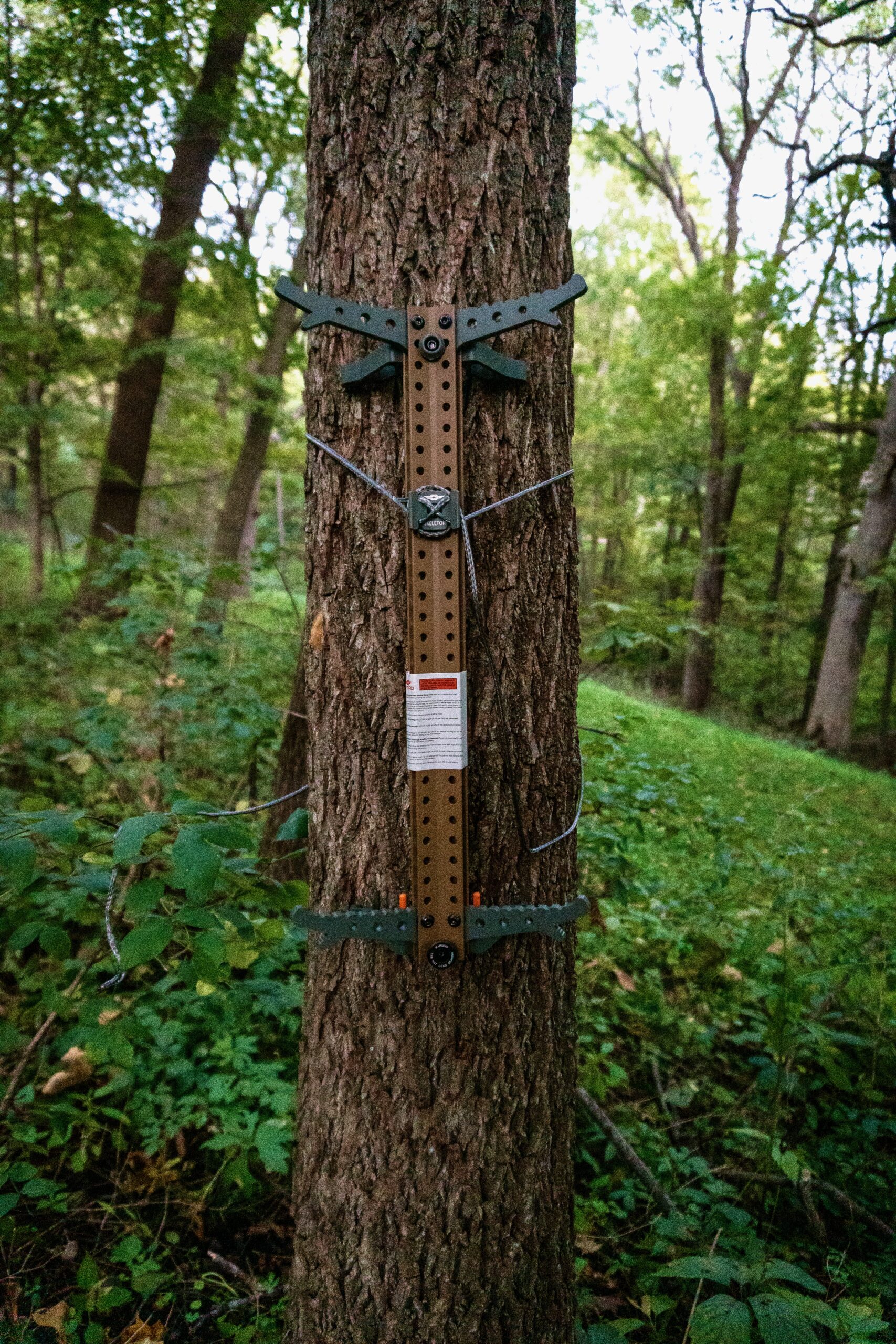
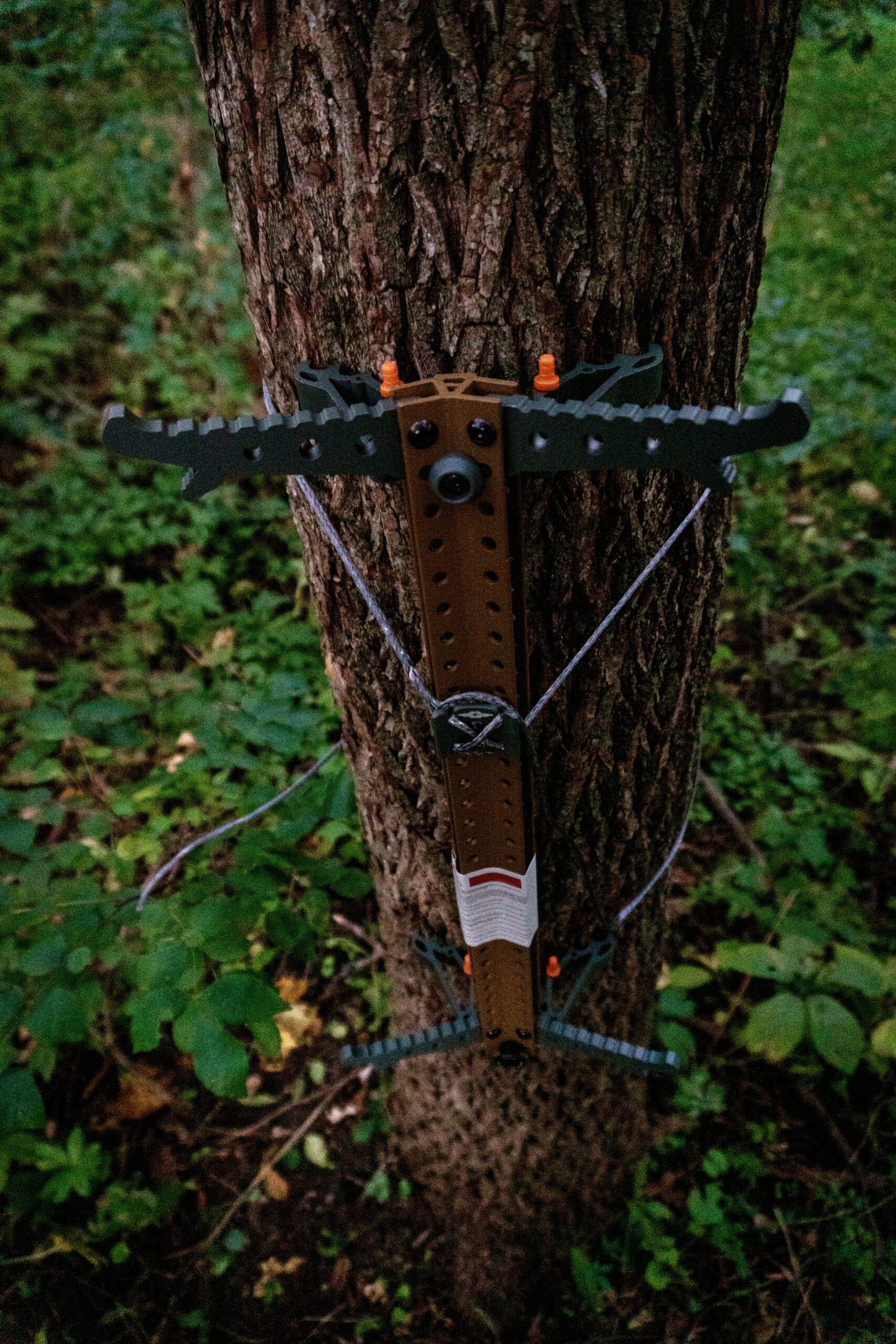
You get a lot of features for the money, but there is a trade off—weight. An all-aluminum design means the Skeletors are roughly double the weight of the One sticks, weighing in at just over 2 pounds per stick. If you don’t mind carrying an 8 pound four-pack, the Skeletors are a feature-rich option for the mobile bowhunter.
Quietest: Timber Ninja C1 Climbing Stick
Key Features
- Weight: 5 pounds 5.5 ounces (four sticks); 1 pounds 4.4 ounces per stick
- Length: 18 ⅛ inches (step to step)
- Packed Dimensions: 20 ⅛-inches long, 9 ⅝-inches high, 8 ⅞-inches wide
- Attachment: 70 ⅛ inches of 6mm cord
- Material: Carbon fiber
- Stackability Score: 3
- Noise Score: 5
- Climbing Comfort Score: 3
Pros
- Made in the USA.
- Lightweight and noise-dampening
- Built-in climbing aider
Cons
- Expensive
Founder and designer, Jason Redd, takes great pride in building all of Timber Ninja’s gear in the USA. He’s a hardcore backcountry hunter and whitetail fanatic who brings over 30 years of hunting experience to his business as well as professional experience in fall-restraints.
The C1 Climbing Stick from Timber Ninja Outdoors is the first of its kind, made entirely out of carbon fiber. Carbon fiber means the C1 stays warm to the touch, even in sub-zero conditions. It also dampens noise much more efficiently than other aluminum or titanium designs. If anything, the hollow “clack” of two C1 sticks knocking against each other sounds more comparable to your favorite pair of rattling antlers than a foreign sound that whitetails would otherwise associate with danger. Users can eliminate even more noise by adding Stealth Strips or choosing a 6mm rope from Timber Ninja’s list of attachment methods.
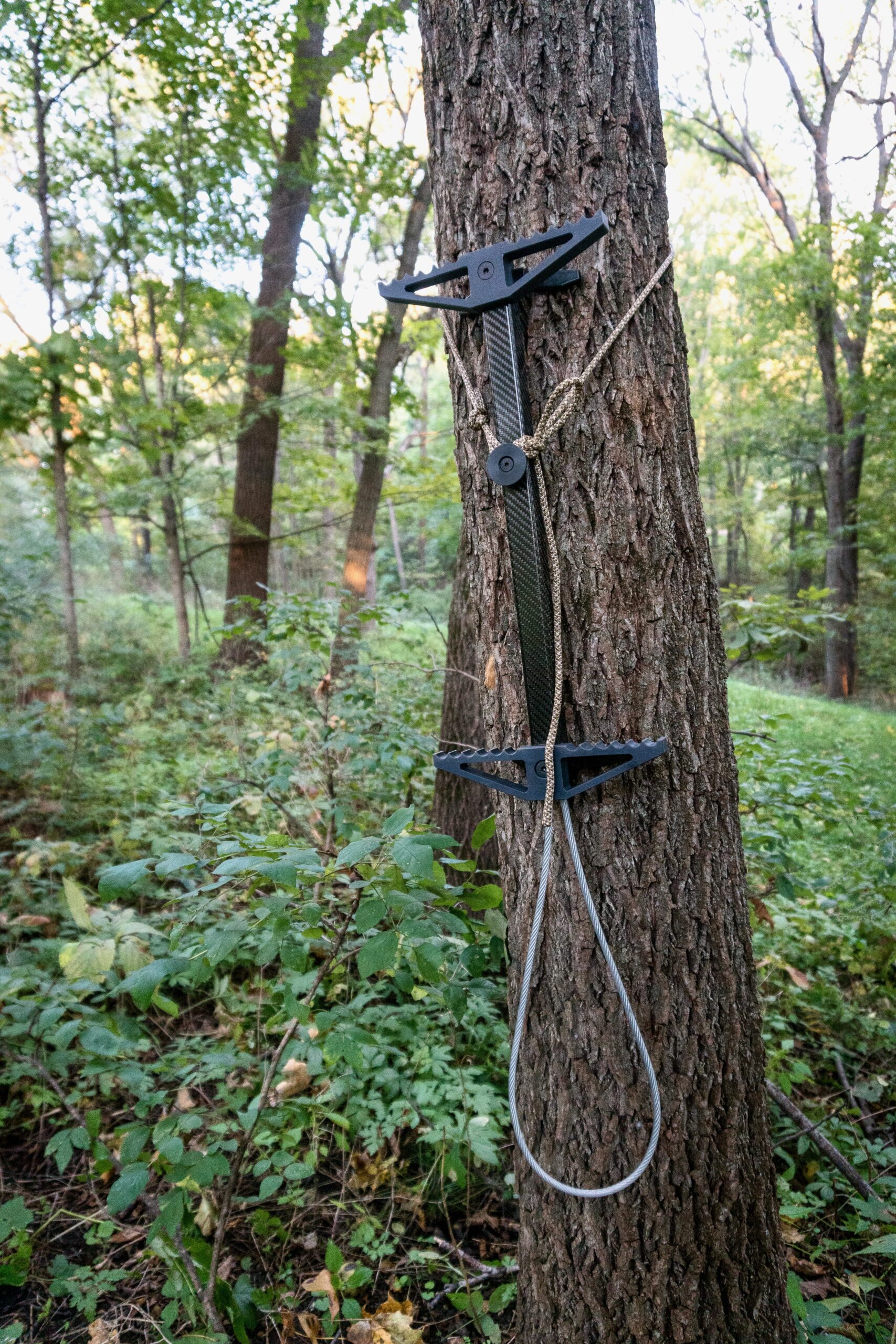
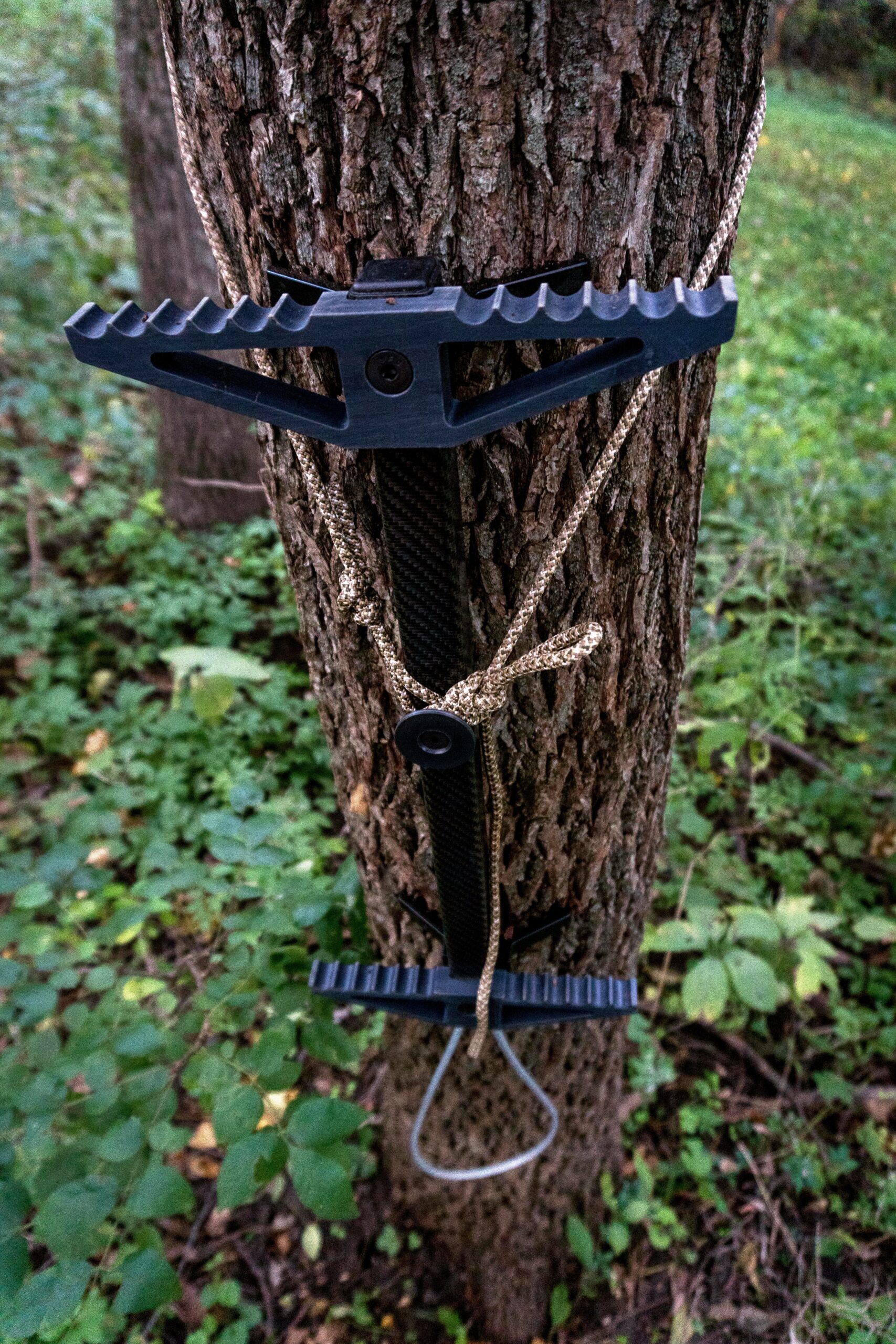
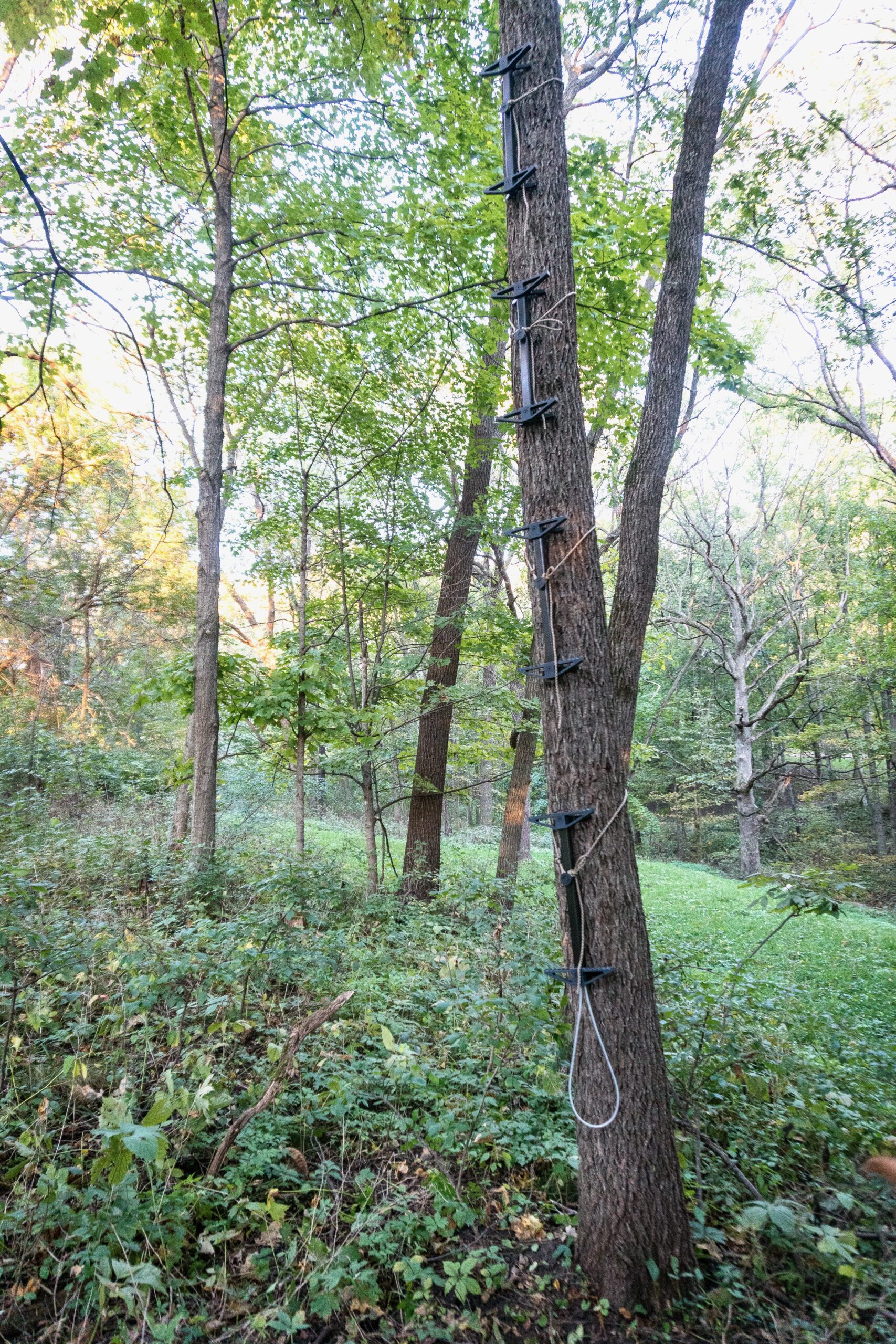
If you choose the rope attachment method, you’ll need to understand how to tie a proper cow hitch knot. If the 70 inches of 6mm cord isn’t enough, you can DIY your own attachment method and apply the same cow hitch knot to effectively climb nearly any tree. Be forewarned, though, if your knot game isn’t strong, you’ll likely appreciate a traditional cam-lock buckle option rather than the lighter and quieter 6mm cord.
Timber Ninja offers an optional, retractable aider for their C1 climbing sticks. Unlike other aiders that hang onto the bottom step, the C1 aider retracts into the hollow carbon tube, stowing away neatly without any extra slop.
Most Compact: Lone Wolf Custom Gear D’Acquisto Series Double Step
Key Features
- Weight: 6 pounds 12 ounces for four sticks; about 1 pound 11 ounces per stick
- Length: 17 ⅛ inches (step to step)
- Packed Dimensions: 20 3/8″ long, 6″ high, 10 ¼” wide
- Attachment: 73 ½ inch cam strap buckle
- Material: 6061 Metal
- Stackability Score: 5
- Noise Score: 1
- Climbing Comfort Score: 4
Pros
- Sleek and packable profile
- Wide foot base
- Integrate with other Lone Wolf Custom Gear treestands
- Easily accept Lone Wolf Custom Gear aiders
Cons
- Assembly required
- Noisy
The D’Acquisto name is synonymous with mobile whitetail hunting, and the Lone Wolf Custom Gear lineup is reflective of the cumulative knowledge shared by Andre and Cody D’Acquisto. The D’Acquisto Series Double Step is the most packable climbing stick in the test, packing to a mere 6-inches high and barely noticeable in your backpack. Hunters can choose from 14, 17, or 20 inch stick lengths. Pre-drilled aider attachment holes make it easy to accept the integrated Lone Wolf Custom Gear aiders.
Assembly is required to get your D’Acquisto Series Double Step sticks up and running. The tolerances are tight, so be careful not to cross-thread your bolts as I did during assembly. Admittedly, I’m not the most mechanically inclined, but if it can happen to me, it could possibly happen to you.
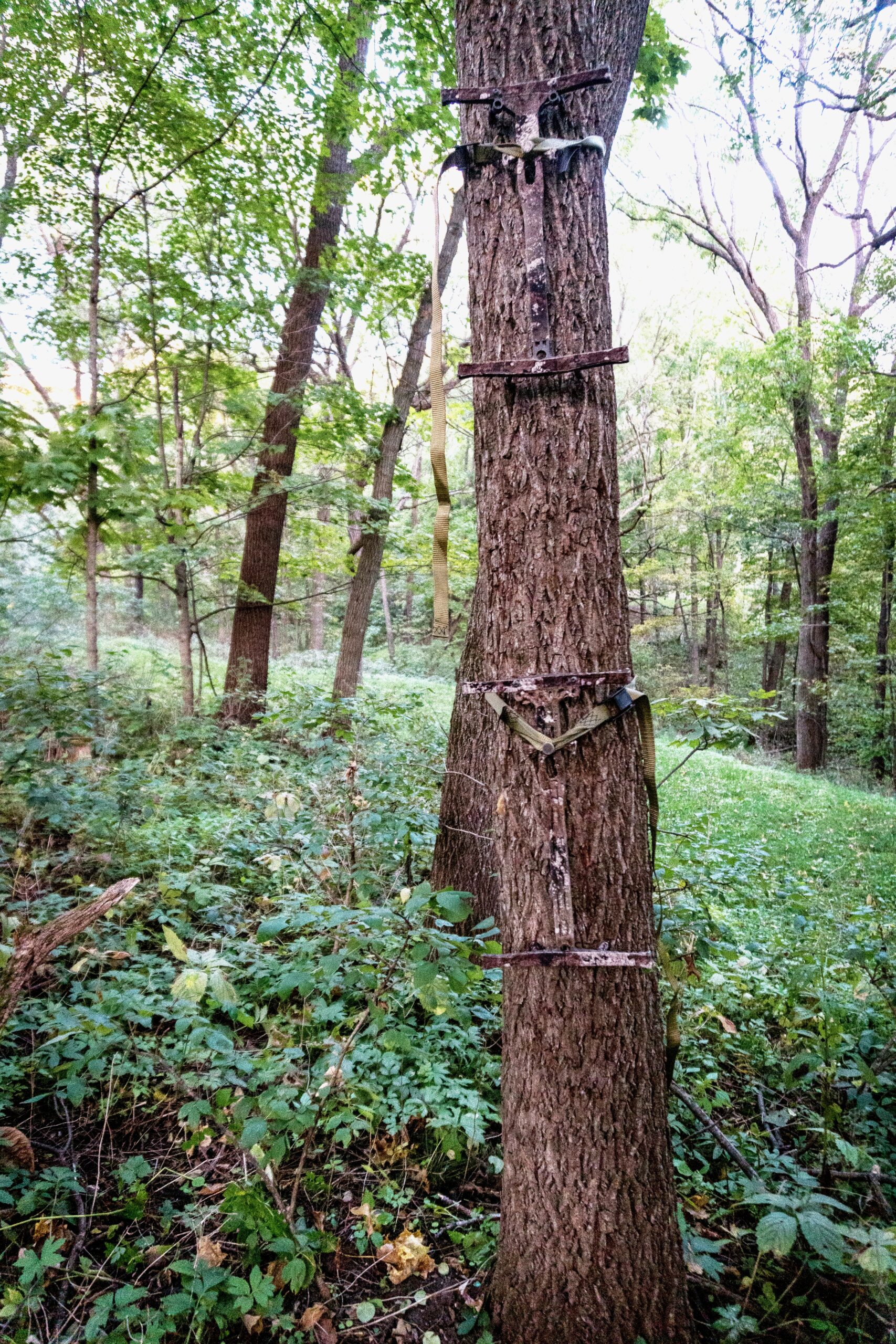
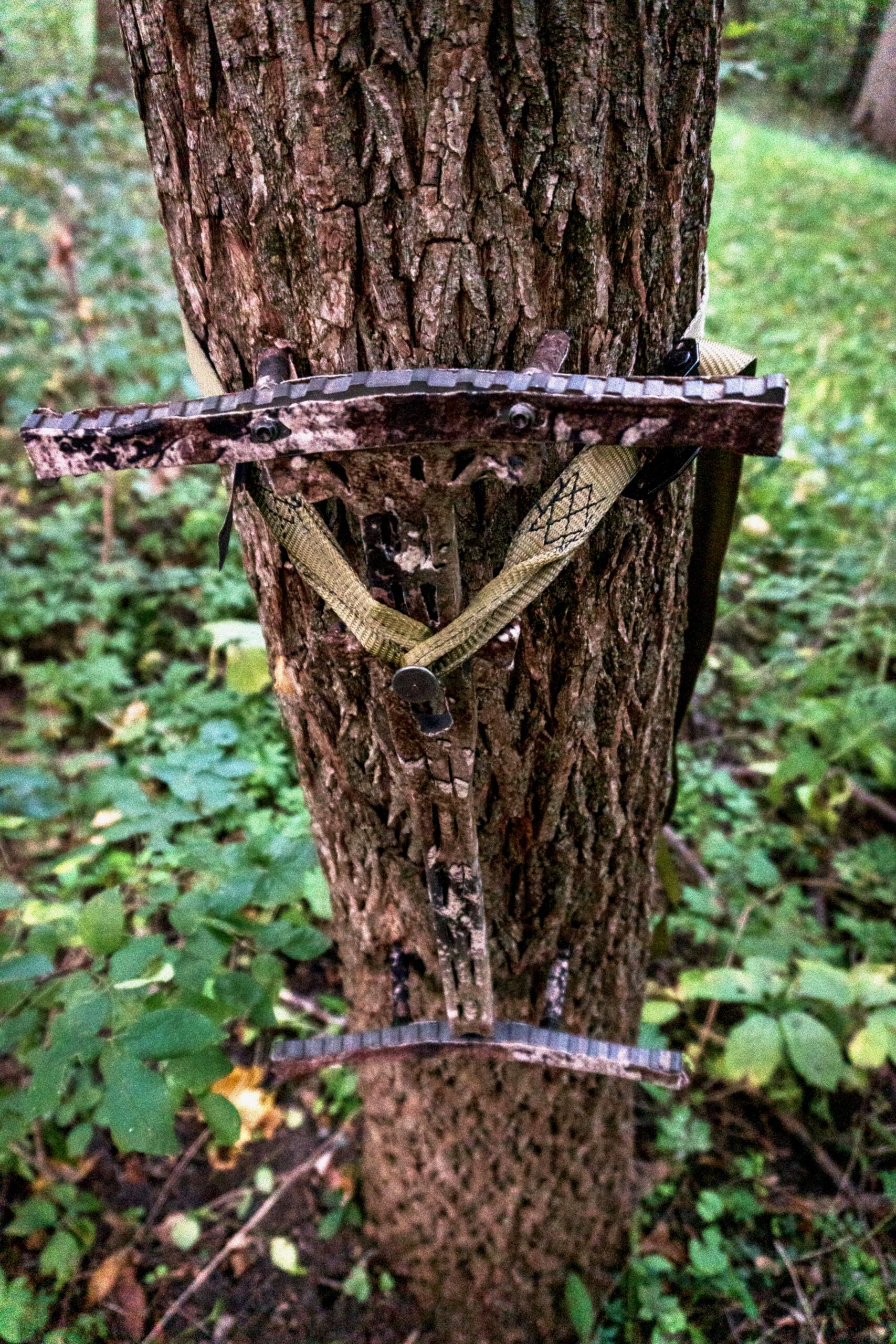
Once assembled, you’ll notice how sleek the sticks stack together. While not as light as other climbing sticks featured in the test, they’re certainly the most packable, earning a top stackability score. If you’re willing to tolerate a minimal weight penalty compared to others, you’ll appreciate the extra space you’ll have in your pack thanks to the stacked dimensions of the Lone Wolf Custom Gear sticks.
You’ll need to get creative with using Stealth Strips or using another aftermarket method to help reduce noise, as the Lone Wolf Custom Gear sticks were the loudest out of the box. The aluminum produces high-pitched “tings” and “clangs” that can send your target buck headed for the next county if you’re not careful. Adding Stealth Strips helped reduce these foreign sounds but didn’t eliminate it.
Timber Ninja A1 Climbing Stick
Key Features
- Weight: 8 pounds for four sticks; about 2 pounds per stick
- Length: 18 ⅛ inches (step to step)
- Packed Dimensions: 20 ⅛-inches long, 9 ⅝-inches high, 8 ⅞-inches wide
- Attachment: 70 ⅛ inches of 6mm cord
- Material: Aluminum
- Stackability Score: 3
- Noise Score: 4
- Climbing Comfort Score: 3
- Optional Accessories: add a built-in aider to each individual stick and choose between a black cam buckle strap or 6mm cord offered in black or desert color options
Pros
- Made in the USA
- Built-in climbing aider
Cons
- More expensive than other climbing sticks positioned as “budget-friendly”
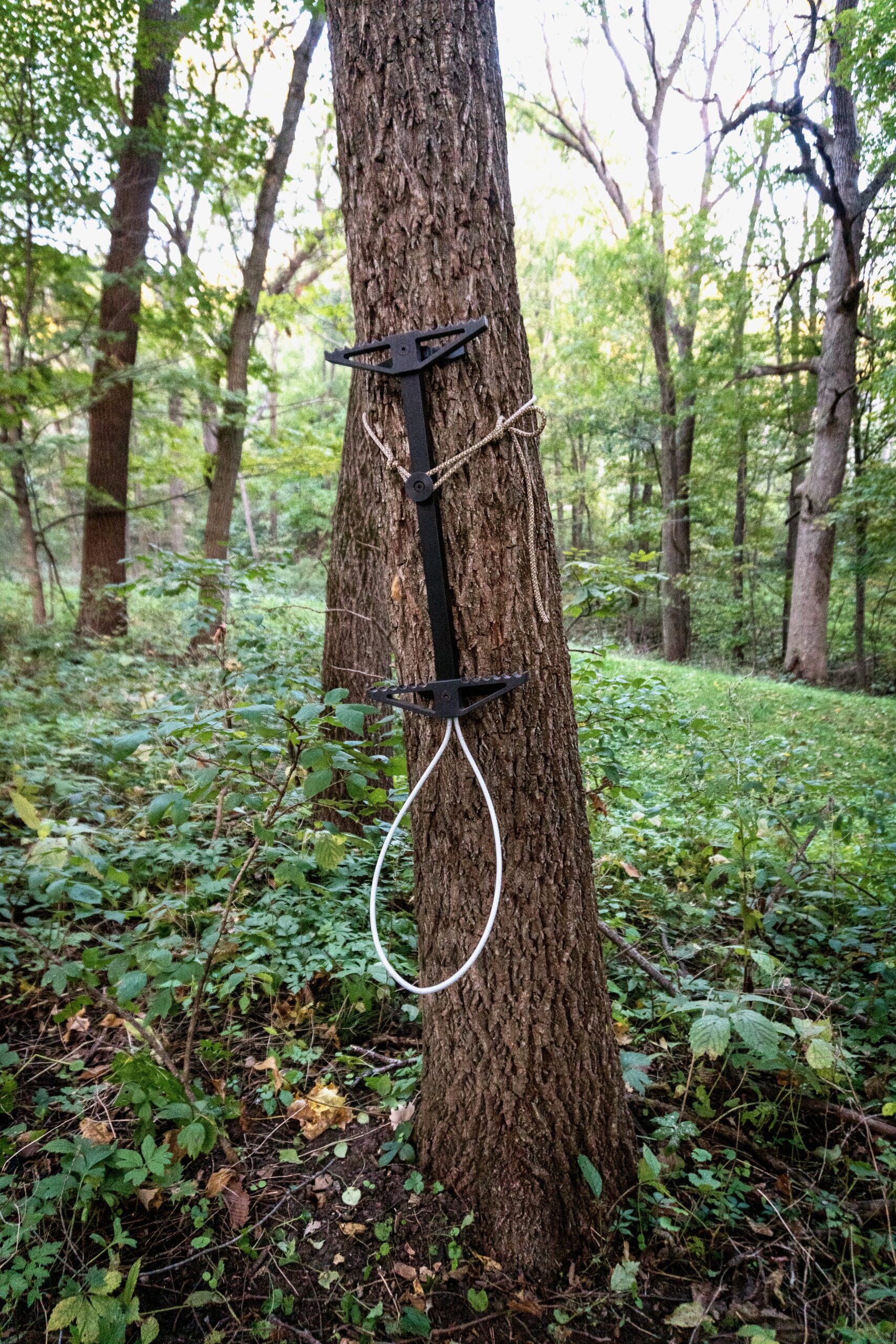
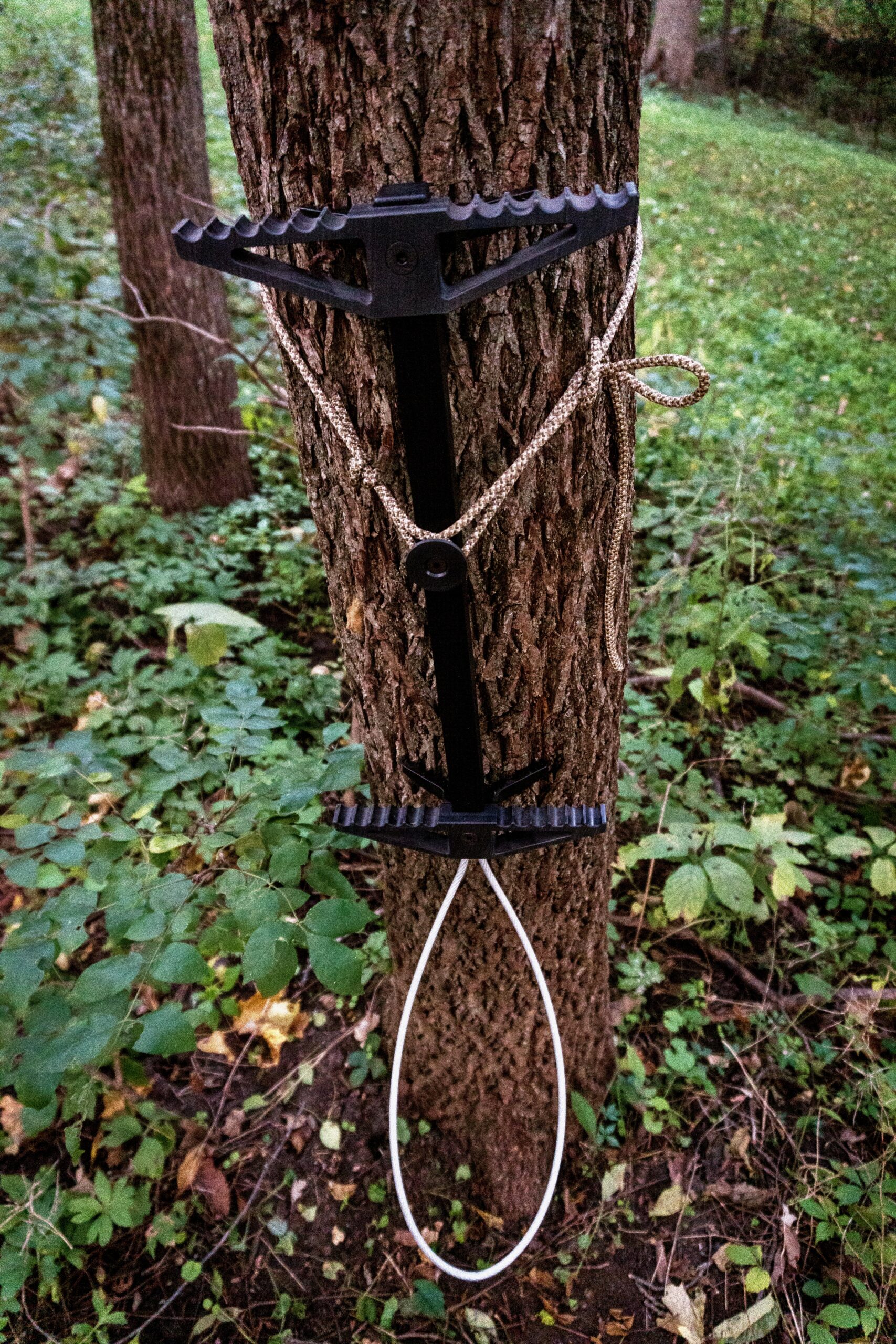
The A1 features the same components and options as the C1, but in an aluminum tube. Aluminum is more affordable than carbon, making the A1 a great option for folks who want a minimalistic climbing stick that’s made in the USA, but lacks C1’s sticker shock. Like the C1, hunters can choose to add an aider. Unlike the C1, A1’s aider loops over the front of the stick and hooks onto the versa knob rather than stowing inside the tube. Admittedly, the A1 aider system isn’t as efficient as the C1, but is still very effective and superior to aftermarket or DIY options.
At around $400 for four, the A1 still isn’t cheap. However, it’s lighter than most other mid-priced aluminum climbing sticks, and comes from a small, reputable company.
Novix Double-Step Climbing Sticks
Key Features
- Weight: 11 pounds 6.9 ounces for four sticks; 2 pounds 13 ounces per stick
- Length: 30 ¼ inches (step to step)
- Packed Dimensions: 36-inches long, 9-inches high, 9-inches wide
- Attachment: 68 inch cam strap buckle
- Material: Aluminum
- Stackability Score: 3
- Noise Score: 3
- Climbing Comfort Score: 5
Pros
- Made in the USA
- Triple step design
- Climbs higher than other options
Cons
- Other options are more mobile
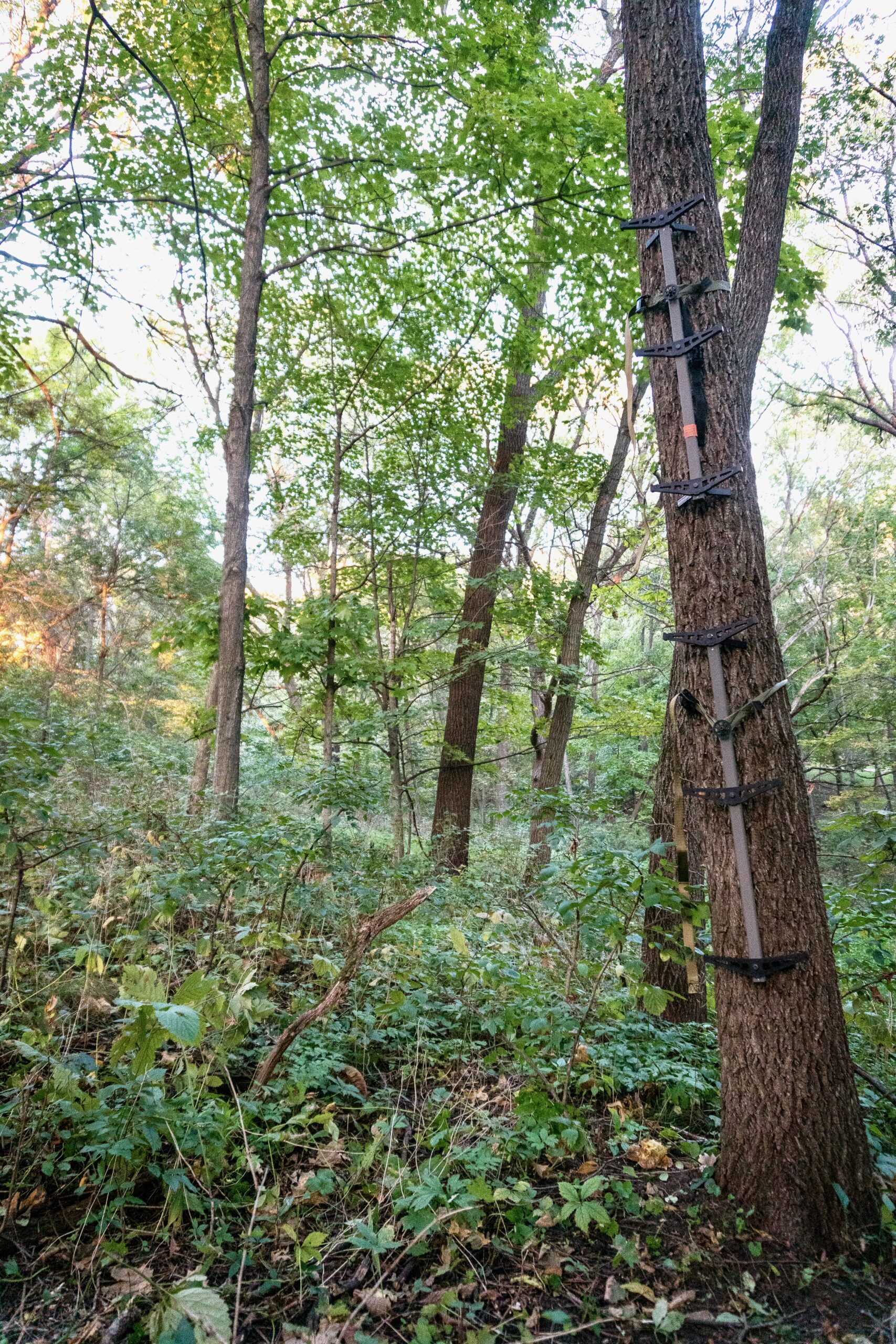
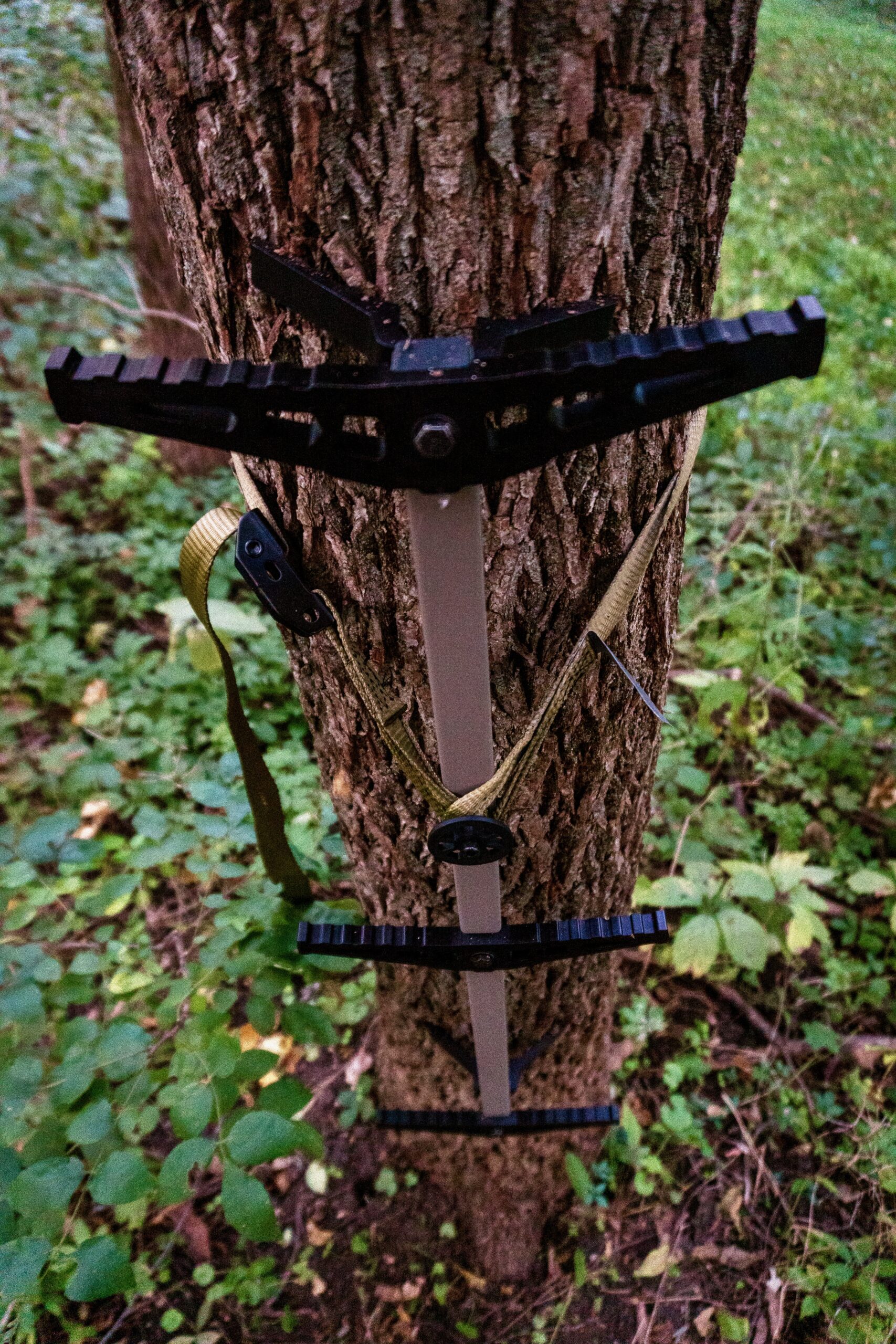
Novix’s 32-inch Double Step allows hunters to climb higher than any other sticks featured in the test. The triple-step design means you don’t need an aider to get to hunting weight with three steps. A pivoting V-bracket helps the sticks grip trees as it rotates, allowing the stick to stay level on crooked trees. When I cinched the sticks to the tree with the included cam buckle strap, the sticks felt solid and I was confident they weren’t going anywhere. The main con is that they aren’t the easiest to pack and they made noise while stacked. While the buckle system helps keep the sticks tight during transport, I wasn’t able to eliminate noise entirely. That’s why I think the Novix sticks are best suited as preset in conjunction with the best hang-on tree stands rather than run and gun setups.
Beast Gear Climbing Stick
Key Features
- Weight: 6 pounds 15.6 ounces; about 1 pound 12 ounces per stick
- Length: 22 inches (step to step)
- Packed Dimensions: 24 ⅜-inches long, 10-inches high, 9-inches wide
- Attachment: 67 ½ inch cam strap buckle
- Material: 6061 Aluminum
- Stackability Score: 3
- Noise Score: 4
- Climbing Comfort Score: 5
Pros
- Aggressively bite the tree resulting in virtually zero slip
- No moving parts
- In-line stacking reduces unwanted noise
Cons
- Stack height is highest in the test
Dan Infalt is considered by many to be one of the best public land bowhunters, and has been at the front of the mobile hunting trend. He turned heads when he released the Beast Gear Climbing Sticks built to spec on what he believes to be the perfect climbing stick.
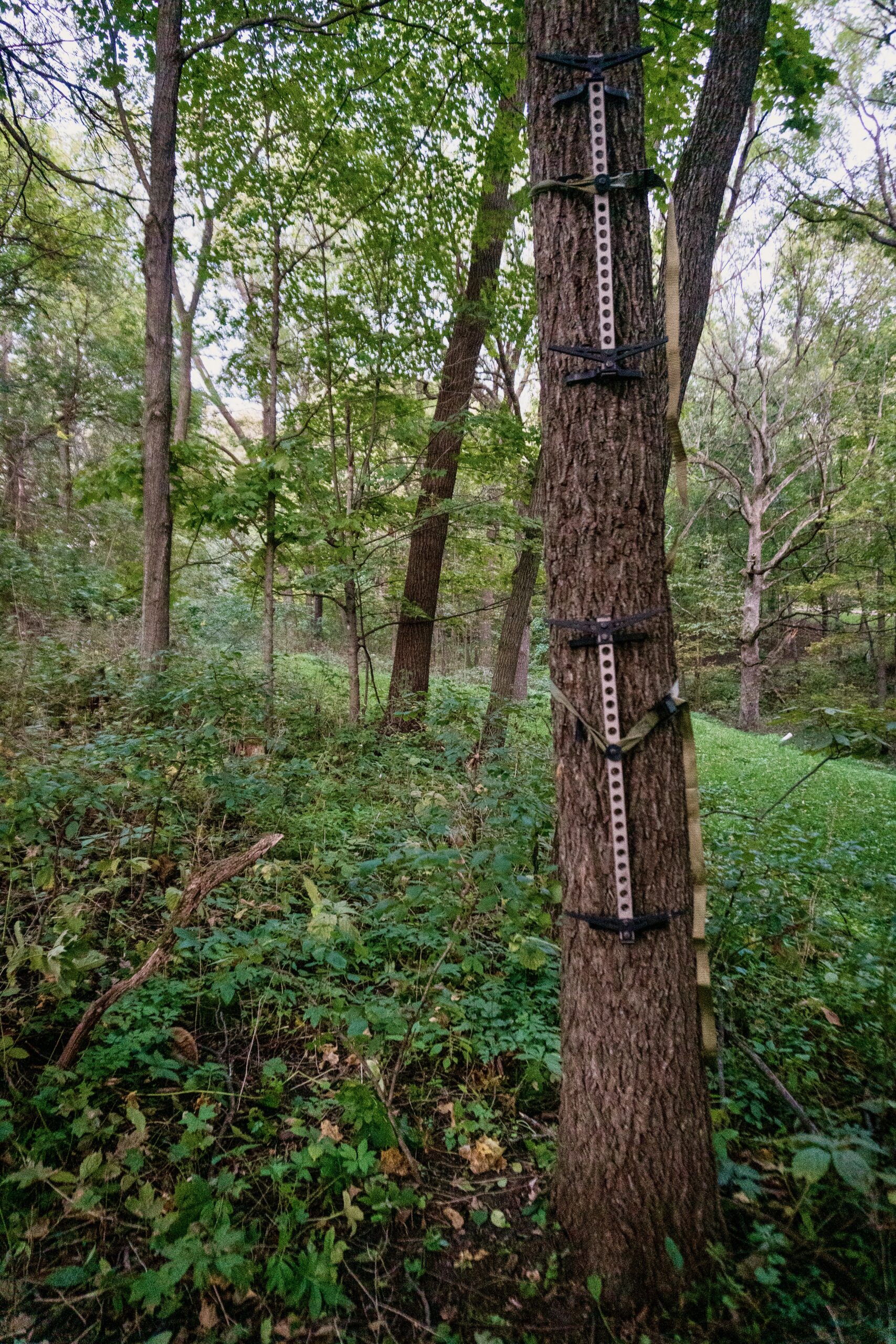
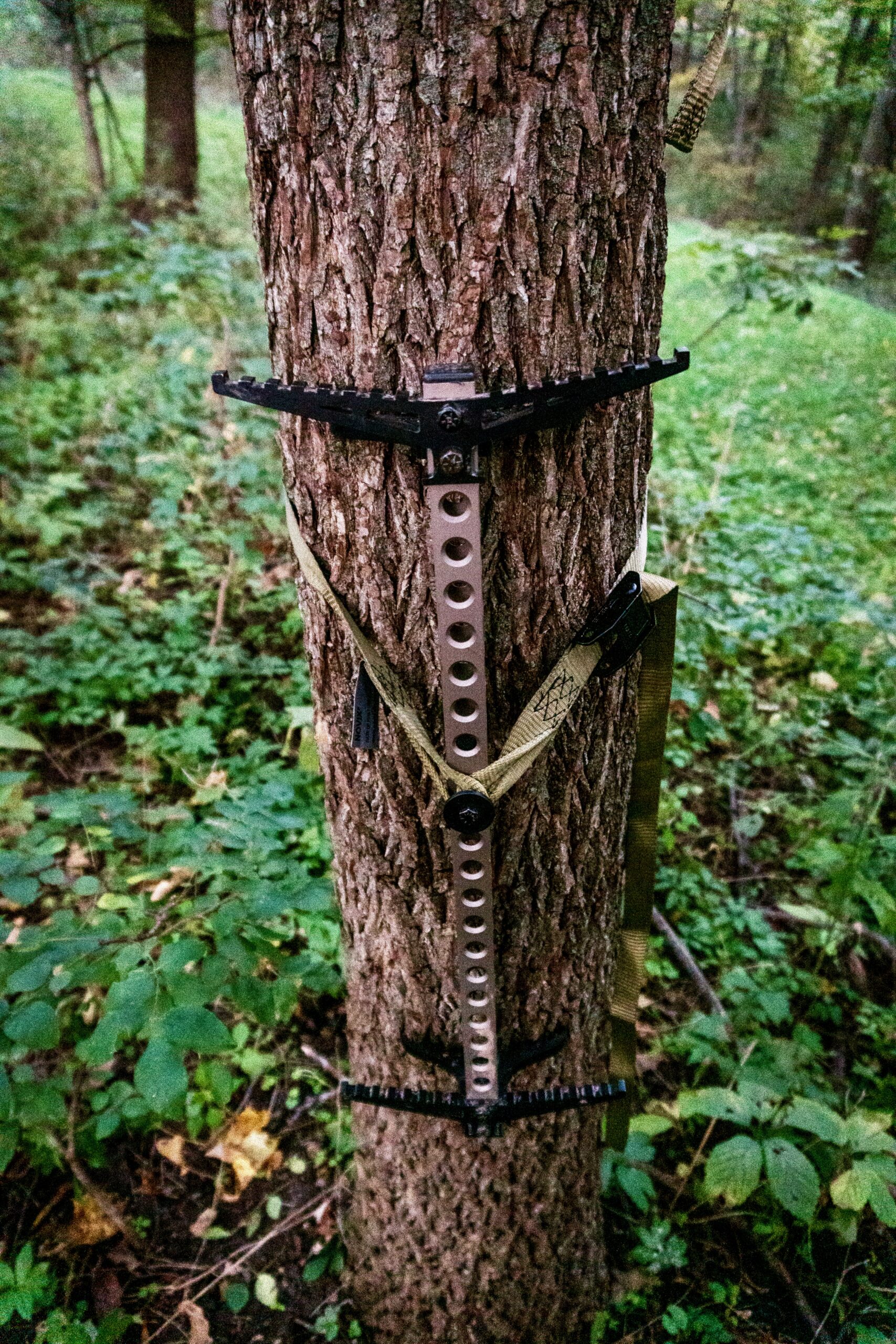
The climbing comfort is where the Beast Gear stick shines. You can easily and quickly hang them on any tree. I also found that the Beast Gear sticks gripped trees better than any stick in the test.
Noise is a big deal when you’re hanging a set 100 yards from a buck bed, and the Beast Gear Sticks are very quiet. They stack tight and when cinched, the Beast Gear sticks produce virtually no noise during transport. However, the aluminum design benefits from aftermarket silencing to achieve a stick that’s truly silent.
How to Choose Climbing Sticks
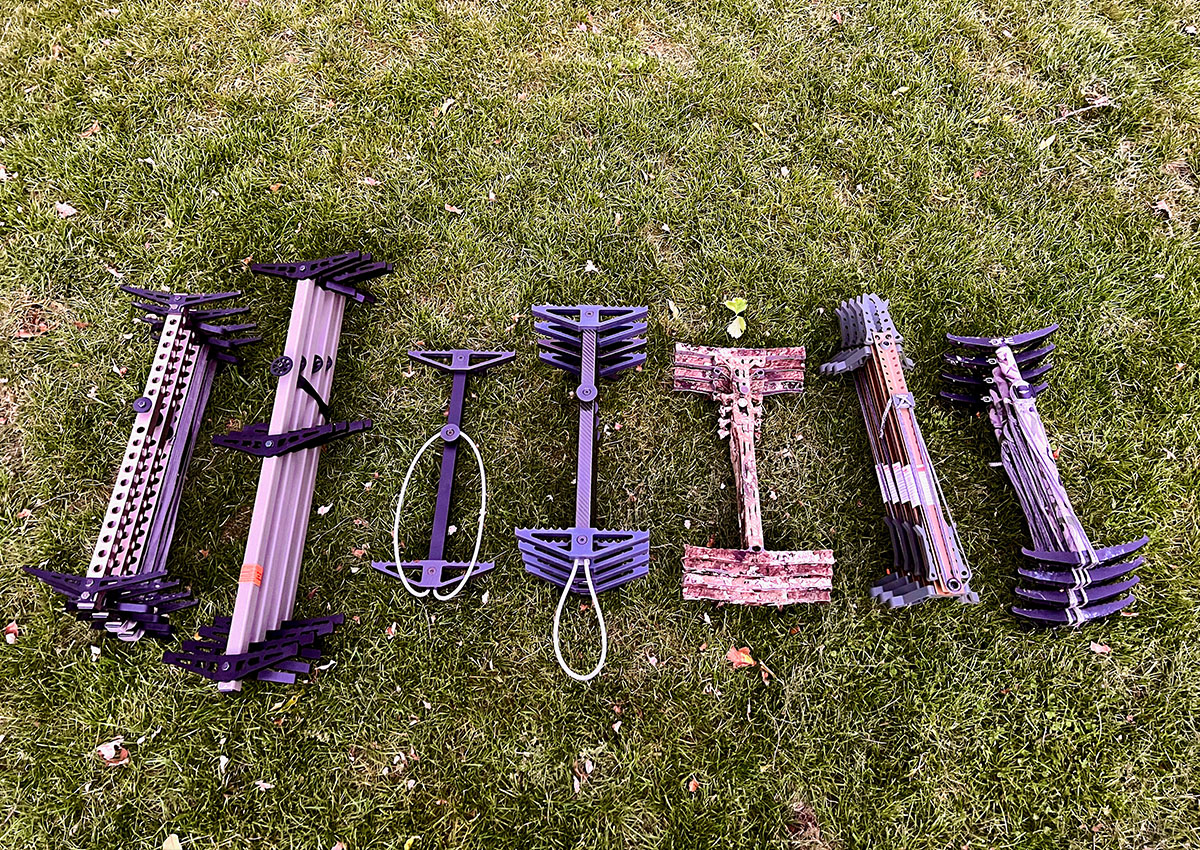
Consider your primary hunting style before you choose a climbing stick. If you find yourself trekking far from the parking lot, weight will likely factor into your decision more than if you’re creeping into a pre-hung stand location.
Another thing to consider is the attachment method. Cam buckles are fast to set up, easy to use, and able to grip the tree incredibly well. But they add extra weight and bulk. Rope and cord attachment methods are silent, but require some knot tying practice and aren’t fool proof.
Final Thoughts
Mobile hunting gear keeps getting better with each passing year—especially sticks and stands. The best climbing sticks are quiet, packable, and instill confidence as you ascend your perch. All of the sticks in this test fulfill these requirements and can help you hunt more effectively.
